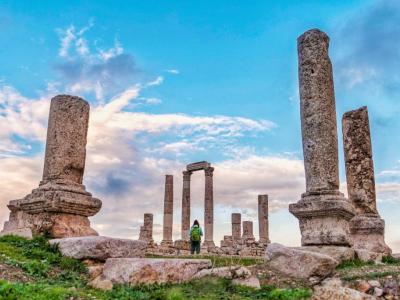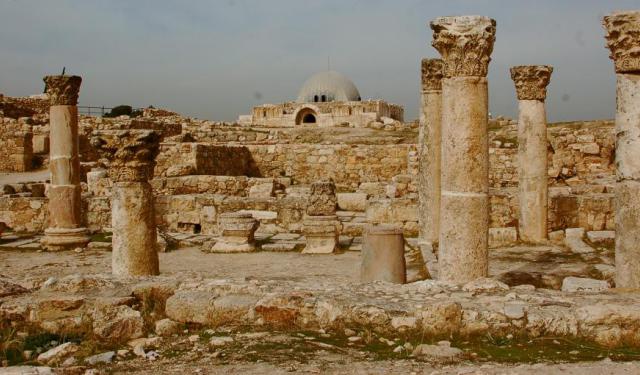Amman Citadel, Amman (must see)
The Amman Citadel, known locally as "Jabal Al-Qal'a," is an iconic archaeological site located in the heart of downtown Amman. Situated on an L-shaped hill, this historic site occupies one of the seven original hills, or "jabals," that formed the foundation of ancient Amman.
With a rich and storied past, the Amman Citadel has witnessed the occupation of numerous great civilizations throughout history. Its history dates back to the Neolithic period, with evidence of human settlement found at the site. Over time, the hill was fortified during the Bronze Age around 1800 BCE. It later served as the capital of the Kingdom of Ammon, a prominent kingdom that rose to power around 1200 BCE.
Throughout its history, the Citadel came under the control and influence of various empires, including the Neo-Assyrian Empire in the 8th century BCE, the Neo-Babylonian Empire in the 6th century BCE, and later the Ptolemies, the Seleucids in the 3rd century BCE, the Romans in the 1st century BCE, the Byzantines in the 3rd century CE, and the Umayyads in the 7th century CE.
Following the Umayyad period, the Citadel experienced a period of decline, and for much of the time until 1878, it remained abandoned and in ruins, occasionally used by Bedouins and seasonal farmers. Despite this gap, the Amman Citadel is recognized as one of the world's oldest continuously inhabited sites.
Today, most of the visible structures at the Citadel date from the Roman, Byzantine, and Umayyad periods. Key archaeological features include the Temple of Hercules, a Byzantine church, and the Umayyad Palace. Additionally, the Jordan Archaeological Museum, built in 1951, is situated on the hill and houses a rich collection of historical artifacts.
While the fortification walls enclose the central part of the site, the ancient periods of habitation covered extensive areas. Various historic structures, tombs, arches, walls, and stairways can be found without modern boundaries, offering significant archaeological potential. Archaeological work has been ongoing at the site since the 1920s, with contributions from Italian, British, French, Spanish, and Jordanian projects. Despite these efforts, a substantial portion of the Citadel remains unexcavated, promising further discoveries and insights into the fascinating history of this ancient landmark.
With a rich and storied past, the Amman Citadel has witnessed the occupation of numerous great civilizations throughout history. Its history dates back to the Neolithic period, with evidence of human settlement found at the site. Over time, the hill was fortified during the Bronze Age around 1800 BCE. It later served as the capital of the Kingdom of Ammon, a prominent kingdom that rose to power around 1200 BCE.
Throughout its history, the Citadel came under the control and influence of various empires, including the Neo-Assyrian Empire in the 8th century BCE, the Neo-Babylonian Empire in the 6th century BCE, and later the Ptolemies, the Seleucids in the 3rd century BCE, the Romans in the 1st century BCE, the Byzantines in the 3rd century CE, and the Umayyads in the 7th century CE.
Following the Umayyad period, the Citadel experienced a period of decline, and for much of the time until 1878, it remained abandoned and in ruins, occasionally used by Bedouins and seasonal farmers. Despite this gap, the Amman Citadel is recognized as one of the world's oldest continuously inhabited sites.
Today, most of the visible structures at the Citadel date from the Roman, Byzantine, and Umayyad periods. Key archaeological features include the Temple of Hercules, a Byzantine church, and the Umayyad Palace. Additionally, the Jordan Archaeological Museum, built in 1951, is situated on the hill and houses a rich collection of historical artifacts.
While the fortification walls enclose the central part of the site, the ancient periods of habitation covered extensive areas. Various historic structures, tombs, arches, walls, and stairways can be found without modern boundaries, offering significant archaeological potential. Archaeological work has been ongoing at the site since the 1920s, with contributions from Italian, British, French, Spanish, and Jordanian projects. Despite these efforts, a substantial portion of the Citadel remains unexcavated, promising further discoveries and insights into the fascinating history of this ancient landmark.
Want to visit this sight? Check out these Self-Guided Walking Tours in Amman. Alternatively, you can download the mobile app "GPSmyCity: Walks in 1K+ Cities" from Apple App Store or Google Play Store. The app turns your mobile device to a personal tour guide and it works offline, so no data plan is needed when traveling abroad.
Amman Citadel on Map
Sight Name: Amman Citadel
Sight Location: Amman, Jordan (See walking tours in Amman)
Sight Type: Attraction/Landmark
Guide(s) Containing This Sight:
Sight Location: Amman, Jordan (See walking tours in Amman)
Sight Type: Attraction/Landmark
Guide(s) Containing This Sight:
Walking Tours in Amman, Jordan
Create Your Own Walk in Amman
Creating your own self-guided walk in Amman is easy and fun. Choose the city attractions that you want to see and a walk route map will be created just for you. You can even set your hotel as the start point of the walk.
Amman Introduction Walking Tour
The capital of Jordan, Amman, is a city that successfully marries rich history with the bustling vibrancy of a modern metropolis. A place where ancient tales and contemporary life intersect.
The earliest evidence of human settlement in the area dates back to the 8th millennium BC. Initially, in the second millennium BC, the city was known as Rabat Aman and served as the capital of the Ammonite... view more
Tour Duration: 2 Hour(s)
Travel Distance: 4.3 Km or 2.7 Miles
The earliest evidence of human settlement in the area dates back to the 8th millennium BC. Initially, in the second millennium BC, the city was known as Rabat Aman and served as the capital of the Ammonite... view more
Tour Duration: 2 Hour(s)
Travel Distance: 4.3 Km or 2.7 Miles
Roman Ruins Walking Tour
Once dominated by the Romans, the modern-day Jordanian capital, Amman, still boasts that legacy. The area known as the Citadel, sitting on the highest hill in Amman, Jebel Al Qala’a, some 850 meters above sea level, offers plenty to see.
Perched atop the Citadel, the Umayyad Palace is a captivating sight. Dating back to the 8th century, it showcases intricate Islamic architecture and affords... view more
Tour Duration: 2 Hour(s)
Travel Distance: 3.0 Km or 1.9 Miles
Perched atop the Citadel, the Umayyad Palace is a captivating sight. Dating back to the 8th century, it showcases intricate Islamic architecture and affords... view more
Tour Duration: 2 Hour(s)
Travel Distance: 3.0 Km or 1.9 Miles





